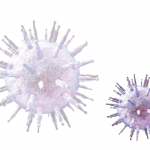
Image Credit: Blackspring/shutterstock.com
SAN FRANCISCO—Two hundred years ago, physicians knew nothing about what caused various forms of arthritis. Today, we have more clues about what may trigger rheumatic diseases, but still can’t pinpoint the culprits that set scores of inflammatory conditions in motion.
Researchers discussed some of the background and recent findings that point to what immunologists call inflammation’s “original sin” at the American College of Rheumatology’s Basic Research Conference on Nov. 6, 2015, the precursor to the 2015 ACR/ARHP Annual Meeting. Infectious agents, such as the widespread Epstein-Barr virus (EBV), and the connections between genes and environmental agents point us in the right direction to find the source of autoantibody responses that lead to inflammation, bone erosion and other hallmarks of rheumatic diseases, the panelists said. Even if we do not yet know the sin or sins that trigger illness, we are moving in the right direction.
“By 2065, will we be able to understand where the origins of rheumatoid arthritis and lupus really come from? I think the likelihood is high,” said John B. Harley, MD, PhD, director of the Center for Autoimmunity Genomics and Etiology at Cincinnati Children’s Hospital. Speaking on possible infectious triggers in rheumatic diseases, Dr. Harley pointed to the currently murky understanding of the exact infections that cause such diseases as septic arthritis or reactive arthritis. When autoimmune diseases have many possible triggering agents, it creates huge problems in developing therapies, he said.
EBV a Likely Culprit
EBV infection often is suspected as a major contributing factor to autoimmune diseases, Dr. Harley said. One of the most common viruses affecting humans and very easily spread, EBV could be the triggering agent in RA or lupus. Although still unclear for RA, it is a likely culprit in lupus, Dr. Harley said. He described seeing an identical twin pushing a sibling into an arthritis clinic, and said, “There has to be some trigger in the environment.”
He cited a 2015 paper published in Arthritis Research & Therapy by researchers at the University of Aberdeen in Scotland that looked at whether prior infection with EBV was more common in RA patients compared with controls, performing a systematic review and meta-analysis of 23 studies that reported RA patients having a prevalence of anti-EBV antibodies in their sera.1
The virus was suspected as a trigger for various reasons, including past studies that showed that RA patients had a 10-fold higher EBV viral load in their peripheral blood. In addition, RA patients spend a high percentage of their T cell response to suppress EBV, and EBV infects plasma cells in the synovium, Dr. Harley said. Yet this study didn’t establish a significant association between RA and serological markers of EBV infection like anti-EBNA-1 IgG or anti-EA.
The evidence for EBV as the infectious trigger that causes lupus autoimmunity is much clearer, he said.2 The high presence of antibodies to EBV nuclear antigen-1 (anti-EBNA-1) in patients’ sera suggests that this viral infection is a key environmental risk factor for later development of lupus.
“Lupus patients make a lot of antibodies. It’s dropping out of the solution because it is so concentrated,” Dr. Harley said. Patients have autoantibodies for years before a lupus diagnosis, and can have high levels of these autoantibodies for as many as five years before symptoms show, he said. Those anti-EBNA-1 antibodies bind to lupus-specific autoantigens, such as Ro. Lupus patients often have a 15- to 40-fold increase in Epstein-Barr viral loads, an increased number of EBV-infected B cells, and increased EBV gene expression.
How Genes Come into Play
Somehow, infectious agents interact with an individual’s genetic susceptibility to trigger disease. “Eventually, we will understand the connections between genetics and the environment” in autoimmune diseases, said Dr. Harley.
We still know very little about the genetics of the initiation of disease, said his fellow panelist, V. Michael Holers, MD, head of the Division of Rheumatology at the University of Colorado, Denver. He spoke more about how genes and environment intersect in RA, and referred to a multi-laboratory project to explore the pathogenesis of early RA, the Studies of the Etiology of Rheumatoid Arthritis (SERA), which he co-founded in 2002. SERA’s work includes identifying high-risk populations of individuals who as yet don’t have clinically apparent disease.
“What are the biomarkers and autoantibodies in the evolution of seropositive RA?” Dr. Holers asked. Patients will move through four phases on the road to RA: genetic risk, preclinical autoimmunity, initial signs and symptoms of disease, and then classifiable, clinical disease.
Two biomarkers are important clues in SERA’s findings. Seropositive RA patients exhibit rheumatoid factor (RF) and antibodies to citrullinated protein antigens (ACPA), he said. ACPA is highly specific for RA, and citrullinated proteins are present in the synovium and lungs of patients with RA, sites of inflammation. Using serum data on 83 patients with current RA from the U.S. Department of Defense’s Army-Navy Serum Repository, researchers found signs that ACPA response rapidly expands prior to the development of clinically apparent disease.3
“What was the first epitope reactivity, or the original sin” that sets the process of autoimmunity in motion, Dr. Holers said. RA patients often have a robust expansion of inflammatory biomarkers like cytokines and chemokines in their blood before clinically apparent disease. In addition, the effector functions of ACPA evolve as RA develops in the time before the patient is symptomatic, he said. “ACPAs become more potent as the disease progresses, as it picks up more effective aspects of complement.”
It’s important to be able to identify and perform intensive, deep phenotyping of people who are both antibody positive and genetically at risk in order to one day intervene early, before inflammation can begin to damage joints, and to improve therapies, he said.
The lungs are a good place to look for clues that a person may be at risk for RA. Lung disease is associated with elevations of RA-related, anti-CCP3.1 autoantibodies, and smoking tobacco and breathing silica particulate matter are two risk factors for RA, Dr. Holers noted.
In one paper published in Arthritis & Rheumatology in 2014, researchers described the results of DNA barcoding to sequence antibodies expressed by plasmablasts in the blood serum of RA patients, he said.4 Their analysis results of isotype frequencies in this population showed a dramatic skewing to IgA, antibodies that are largely found in mucosal surfaces such as the linings of the lungs.
“There is increasing evidence that mucosal inflammation is driving this disease,” said Dr. Holers. Whether in gingivitis, periodontitis or pulmonary disease, the original sin’s trail may begin on mucosal surfaces.
But how do genes come into play? “We are on the road to understanding genetics, but we still don’t know how many genetic factors are involved in each phase of this disease,” said Dr. Holers. “We know some of the fundamental principles, such as that genes play a role in the high affinity for ACPA responses in these individuals, specifically in the preclinical period.”
Second Chance
If you missed this session, it’s not too late. Catch it on SessionSelect
Susan Bernstein is a freelance medical journalist based in Atlanta.
References
- Ball RJ, Avenell A, Aucott L. Systematic review and meta-analysis of the sero-epidemiological association between Epstein-Barr Virus and rheumatoid arthritis. Arthritis Res Ther. 2015 Sep 29;17(1):274.
- Harley JB, James JA. Epstein-Barr virus infection induces lupus autoimmunity. Bull NYU Hosp Jt Dis. 2006;64(1–2):45–50.
- Majka DS, Deane KD, Parrish LA, et al. The duration of pre-clinical rheumatoid arthritis-related autoantibody positivity increases in subjects with older age at time of disease diagnosis. Ann Rheum Dis. 2008 Jun;67(6):801–807.
- Tan YC, Kongpachith S, Blum LK, et al. Barcode-enabled sequencing of plasmablast antibody repertoires in rheumatoid arthritis. Arthritis Rheumatol. 2014 Oct;66(10):2706–2715.


